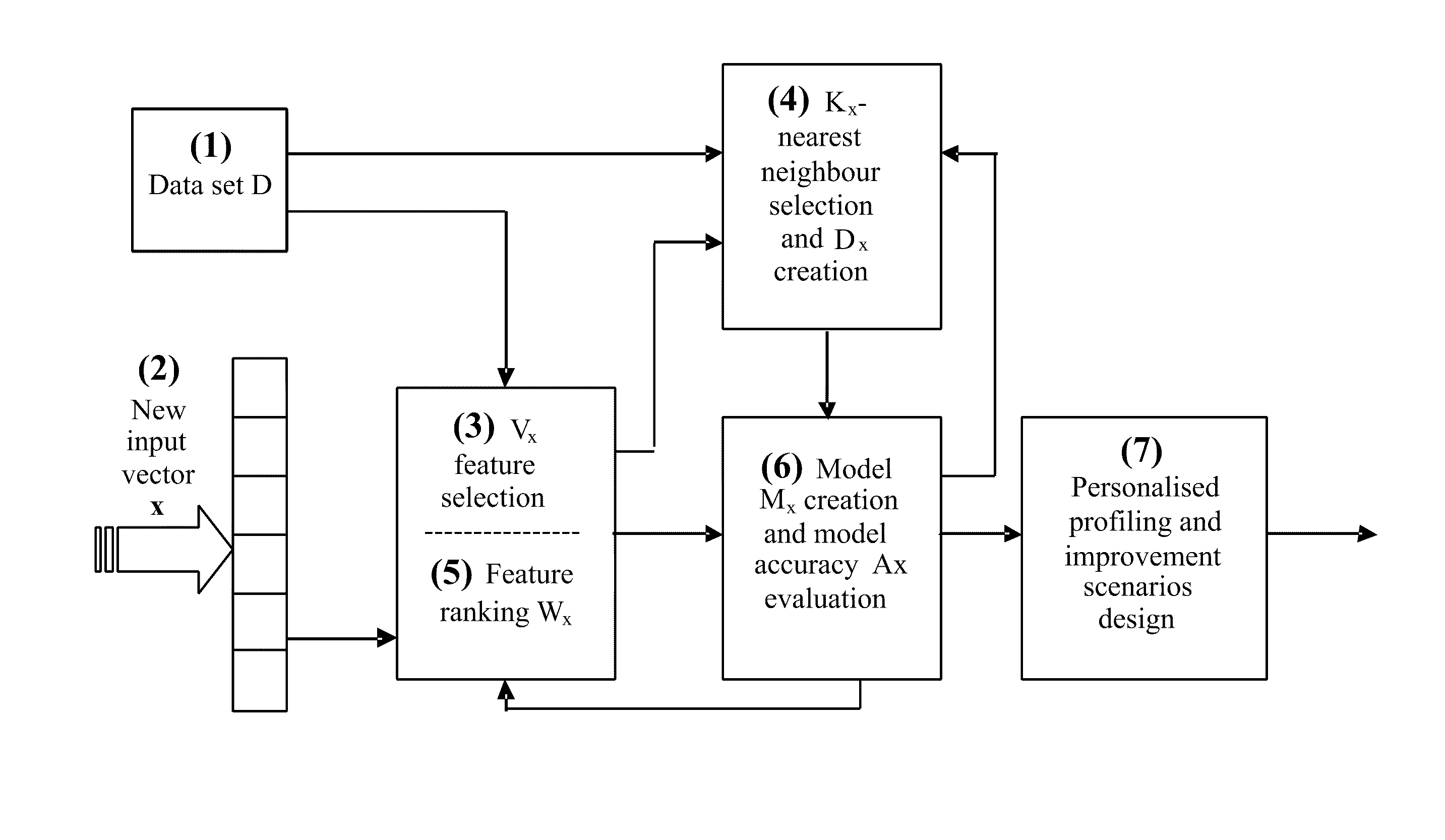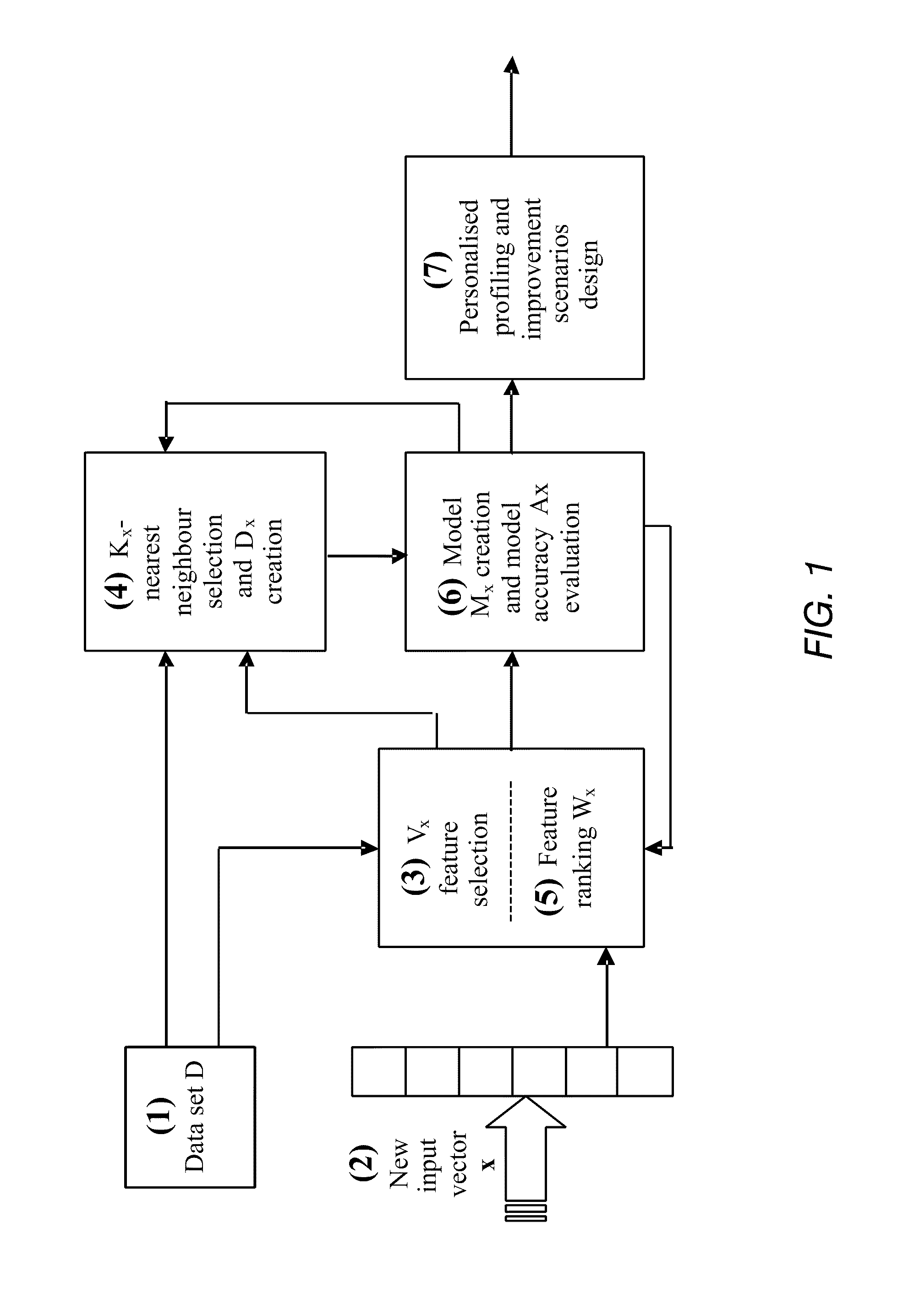Data analysis and predictive systems and related methodologies
a predictive system and data analysis technology, applied in the field of data analysis and predictive systems, can solve the problems of insufficient data analysis methods and systems which can produce high, methods that do not select specific subsets of features and precise neighbourhood of samples for a specific individual, and a relatively large number of patients who will not benefit at all from drug treatmen
- Summary
- Abstract
- Description
- Claims
- Application Information
AI Technical Summary
Benefits of technology
Problems solved by technology
Method used
Image
Examples
example 1
Classifying Rock Versus Mine Based on the Reflection of Sonar Signal
[0162]This may be a standard bench mark data net available from the Machine learning repository of UC Irvine:
(http: / / archive.ics.uci.edu / ml / datasets / Connectionist+Bench+%28Sonar%2C+Mines+vs.+Rocks%29).
[0163]The data set was contributed to the benchmark collection by Terry Sejnowski, now at the Salk Institute and the University of California at San Diego. The data set was developed in collaboration with R. Paul Gorman of Allied-Signal Aerospace Technology Center.
[0164]The data contains 208 samples classified in two classes—rock vs mine based on 60 variables, continuous value between 0 and 1—reflections of a sonar signal from the objects (mine or rock) in different frequency bands. The task is to classify any new input vector of 60 or less such variables into one of the two classes—rock or mine. While a global approach of using one neural network of the type of a multilayer perceptron and a backpropagation learning al...
example 2
Personalised Modeling for the Evaluation (Prediction) of Renal Function
[0184]In another implementation the method can be used for the evaluation of the level of function of a biological system or an organ of an individual, such as the functioning of the heart, the kidney, etc. This is illustrated here on a case study problem of renal function evaluation based on Glomerular Filtration Rate (GFR) as an accurate renal indicator.
[0185]Several nonlinear formulas have been used in practice as “golden standard” global models. The Gates formula (Gates, 1985) uses three variables: age, gender, and serum creatinine, while the MDRD formula (Levey, 1995) uses six variables: age, sex, race, serum creatinine, serum albumin and blood urea nitrogen concentrations. While the existing formulas predict the GFR for patients from different geographic areas with different accuracy, there is no systematic way to adapt these formulas to new data and to personalize the prediction. The method suggested in (M...
example 3
Personalised Modeling for Longevity Prediction of Dialysis Patients
[0192]In another implementation, the described technology can be used to predict the longevity of a person, based on available data on the longevity of other individuals under similar conditions.
[0193]This is illustrated on a case study example of longevity prediction after haemodialysis using the well established DOPPS data as explained below.
[0194]A medical dataset is used here for experimental analysis. Data originates from the Dialysis Outcomes and Practice Patterns Study (DOPPS, www.dopps.org)—see also: D. A. Goodkin, D. L. Mapes & P. J. Held, “The dialysis outcomes and practice patterns study (DOPPS): how can we improve the care of hemodialysis patients?” Seminars in Dialysis, Vol. 14, pp. 157-159, 2001.
[0195]The DOPPS is based upon the prospective collection of observational longitudinal data from a stratified random sample of haemodialysis patients from the United States, 8 European countries (United Kingdom,...
PUM
 Login to View More
Login to View More Abstract
Description
Claims
Application Information
 Login to View More
Login to View More - R&D
- Intellectual Property
- Life Sciences
- Materials
- Tech Scout
- Unparalleled Data Quality
- Higher Quality Content
- 60% Fewer Hallucinations
Browse by: Latest US Patents, China's latest patents, Technical Efficacy Thesaurus, Application Domain, Technology Topic, Popular Technical Reports.
© 2025 PatSnap. All rights reserved.Legal|Privacy policy|Modern Slavery Act Transparency Statement|Sitemap|About US| Contact US: help@patsnap.com



